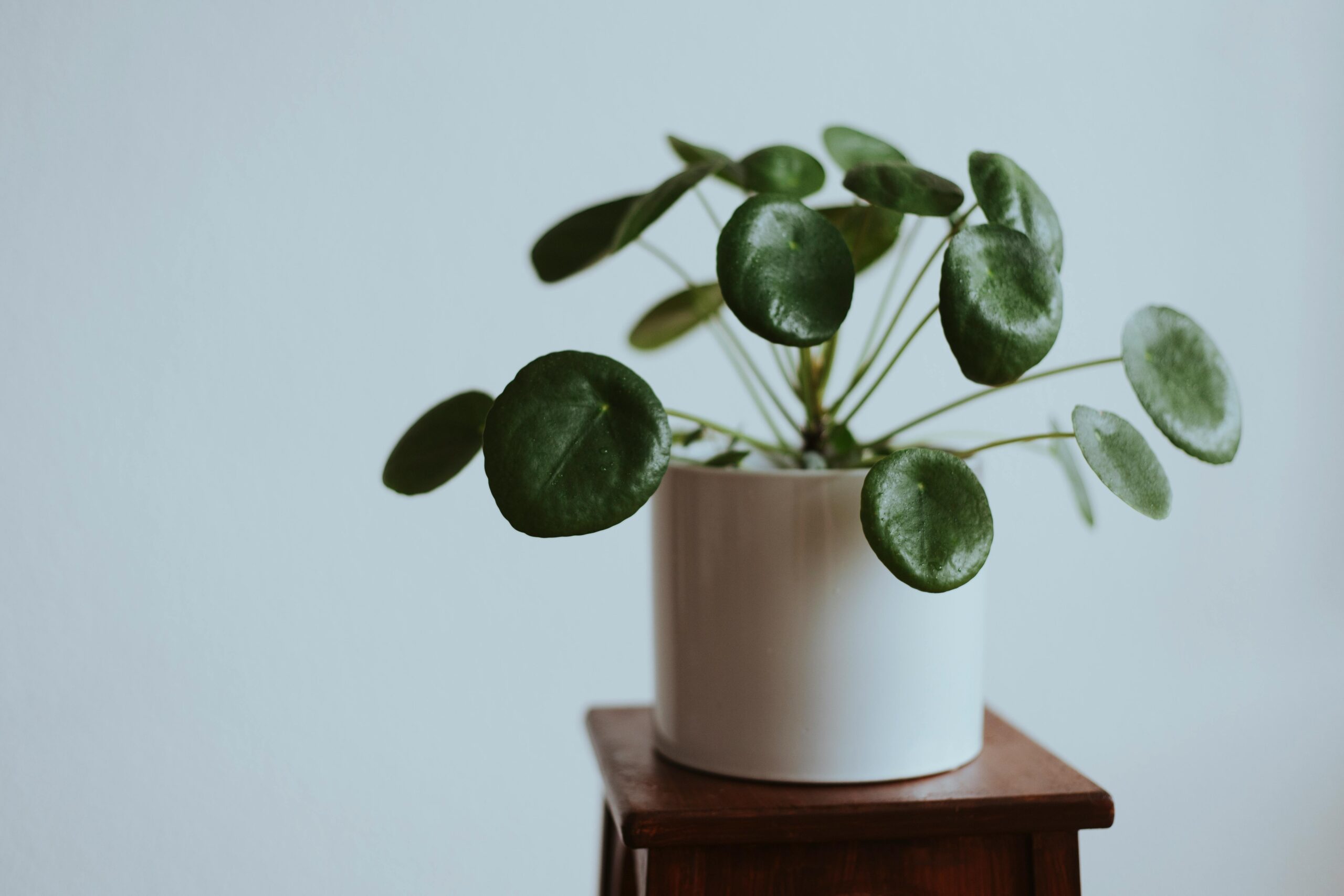
Botanical Overview:

- Species and Varieties:
- Pilea peperomioides is the most common variety grown as a houseplant
- Other varieties:
- Pilea cadierei (Aluminum Plant, known for silvery markings on leaves)
- Pilea glauca (Baby Tears, tiny leaves and a trailing growth habit)
- Pilea is a large genus, but P. peperomioides is the most popular for indoor use due to its unique foliage and ease of care
- Growth Habit:
- Pilea is a fast-growing, low-spreading plant with thick, round, glossy leaves on long stems
- It forms a rosette pattern, with new growth emerging from the center
Ideal Growing Conditions:
- Light:
- Prefers bright, indirect light; too much direct sunlight can scorch its leaves
- Thrives in areas with moderate to high light, such as near east- or west-facing windows
- Can tolerate lower light, but may result in slower growth and fewer new leaves
- Temperature:
- Pilea prefers temperatures between 60°F and 75°F (15°C–24°C)
- It does not tolerate cold temperatures well, so avoid placing it in drafty areas or near air conditioners during winter
- Humidity:
- Enjoys moderate humidity (40%–60%), but can adapt to average indoor humidity levels
- If the air is too dry, consider increasing humidity with misting or using a room humidifier
- Soil:
- Well-draining, light, and airy potting mix is ideal for Pilea
- A typical indoor potting soil mixed with perlite or cactus mix works well to prevent waterlogging and root rot
Watering Pilea:
- Watering Basics:
- Water when the top 1-2 inches of soil feel dry to the touch
- Thoroughly water the plant until water drains from the bottom of the pot, but avoid letting it sit in standing water
- Signs of Overwatering:
- Yellowing leaves, mushy stems, and root rot
- Foul smell from the soil can indicate too much moisture
- Signs of Underwatering:
- Wilting, crispy leaf edges, or dry soil
- The plant may look limp or tired when it’s thirsty
- Watering Tips:
- Use room-temperature water, and always allow excess water to drain out of the pot
- Water less frequently during the winter months when the plant’s growth slows down
- Avoid over-watering by ensuring the soil has proper drainage
Fertilizing Pilea:
- When to Fertilize:
- Fertilize during the growing season (spring and summer) once a month
- Reduce or stop fertilizing during the fall and winter months when the plant is not actively growing
- Type of Fertilizer:
- Use a balanced, water-soluble fertilizer (e.g., 10-10-10) diluted to half strength
- A low-nitrogen, high-phosphorus fertilizer can also help encourage more blooms and stronger roots
- How to Fertilize:
- Apply fertilizer when the plant is actively growing and after watering, to avoid fertilizer burn
- Be cautious of over-fertilizing, as too much can cause leaf burn and slow growth
- Signs of Over-Fertilizing:
- Brown leaf tips, weak or leggy growth, or salt build-up in the soil
- If over-fertilized, flush the soil with water to remove excess nutrients
Common Issues and How to Solve Them:
- Yellowing Leaves:
- Causes: Overwatering, underwatering, or too much direct sunlight
- Solutions: Check watering habits, adjust light exposure, and ensure the plant has adequate drainage
- Drooping or Wilting:
- Causes: Underwatering or sudden temperature changes
- Solutions: Water thoroughly when the soil is dry, and keep the plant in a stable environment
- Leggy Growth (Stretching):
- Causes: Insufficient light or overcrowding in a pot
- Solutions: Move the plant to a brighter location and prune back any leggy stems to encourage bushier growth
- Pests:
- Common pests: Mealybugs, aphids, and spider mites
- Solutions: Regularly inspect the plant for pests, wipe down leaves with a damp cloth, or use insecticidal soap or neem oil to treat infestations
- Root Rot:
- Causes: Overwatering or poor drainage
- Solutions: Check the roots for rot (brown/black and mushy) and trim them before repotting into fresh, well-draining soil
Pruning and Maintenance:
- Why Prune Pilea?
- Pruning helps maintain a bushy shape, encourages new growth, and removes dead or damaged leaves
- Can help control the plant’s size and shape, especially in confined spaces or when it’s getting too leggy
- When to Prune:
- Prune during the active growing season (spring or summer)
- Trim back any long, leggy stems or damaged leaves
- How to Prune:
- Use sharp, clean scissors or pruning shears to cut off unwanted growth or dead leaves
- Cut back leggy stems at a node (the small bump on the stem where new growth will emerge) to encourage branching and bushier growth
- Remove spent flowers, if applicable, to help the plant focus on new growth
Repotting Pilea:
- When to Repot:
- Repot every 1-2 years, or when the plant becomes root-bound or outgrows its current pot
- Signs that it’s time to repot: Roots growing out of drainage holes, slow growth, or roots circling around the pot
- Best Potting Tips:
- Choose a pot that is 1-2 inches larger in diameter than the current pot
- Ensure the new pot has drainage holes to prevent water from accumulating in the soil
- Repotting Steps:
- Gently remove the plant from its current pot and inspect the roots
- Trim any dead or rotting roots before placing the plant in a larger pot
- Add fresh, well-draining soil around the root ball and water thoroughly after repotting
Propagation of Pilea:
- How to Propagate:
- Offsets or Pups: Pilea produces “pups” or offsets (small baby plants) that grow at the base of the main plant
- Stem Cuttings: Take a healthy stem with a node, place it in water or directly into soil, and wait for roots to develop
- Propagation Tips:
- Ensure the cutting or pup has a node for root development
- Place the cutting in a warm, humid location with bright, indirect light
- Once roots form, transplant the new plant into its own pot with fresh soil
- Speed of Propagation:
- Pilea can root relatively quickly in water (1-3 weeks), and pups can be separated and replanted when they have a sufficient root system
Benefits of Owning Pilea:
- Low Maintenance:
- Pilea is a forgiving and low-maintenance plant, perfect for new plant owners
- Once you find the right light and watering routine, it’s relatively easy to care for
- Aesthetic Appeal:
- Known for its distinct, round leaves and unique growth habit, Pilea makes a striking addition to any home décor
- Works well in hanging baskets, pots, or as a tabletop centerpiece
- Fast-Growing:
- Pilea grows quickly and produces plenty of new leaves, making it a great plant for those who love seeing quick results
- Pet-Friendly:
- Non-toxic to both cats and dogs, making it a great choice for homes with pets
Fun Facts About Pilea:
- Nickname: Pilea is often called the “Chinese Money Plant” due to its round, coin-like leaves, which are believed to bring good fortune
- Symbolism: The plant is considered a symbol of friendship, and it is commonly propagated and shared among friends
- Historical Trivia: Pilea peperomioides was first introduced to the West by a Norwegian missionary in China, which is why it’s often referred to as the “missionary plant”
- Longevity: With the right care, Pilea can live for many years and continue to produce new leaves and pups

